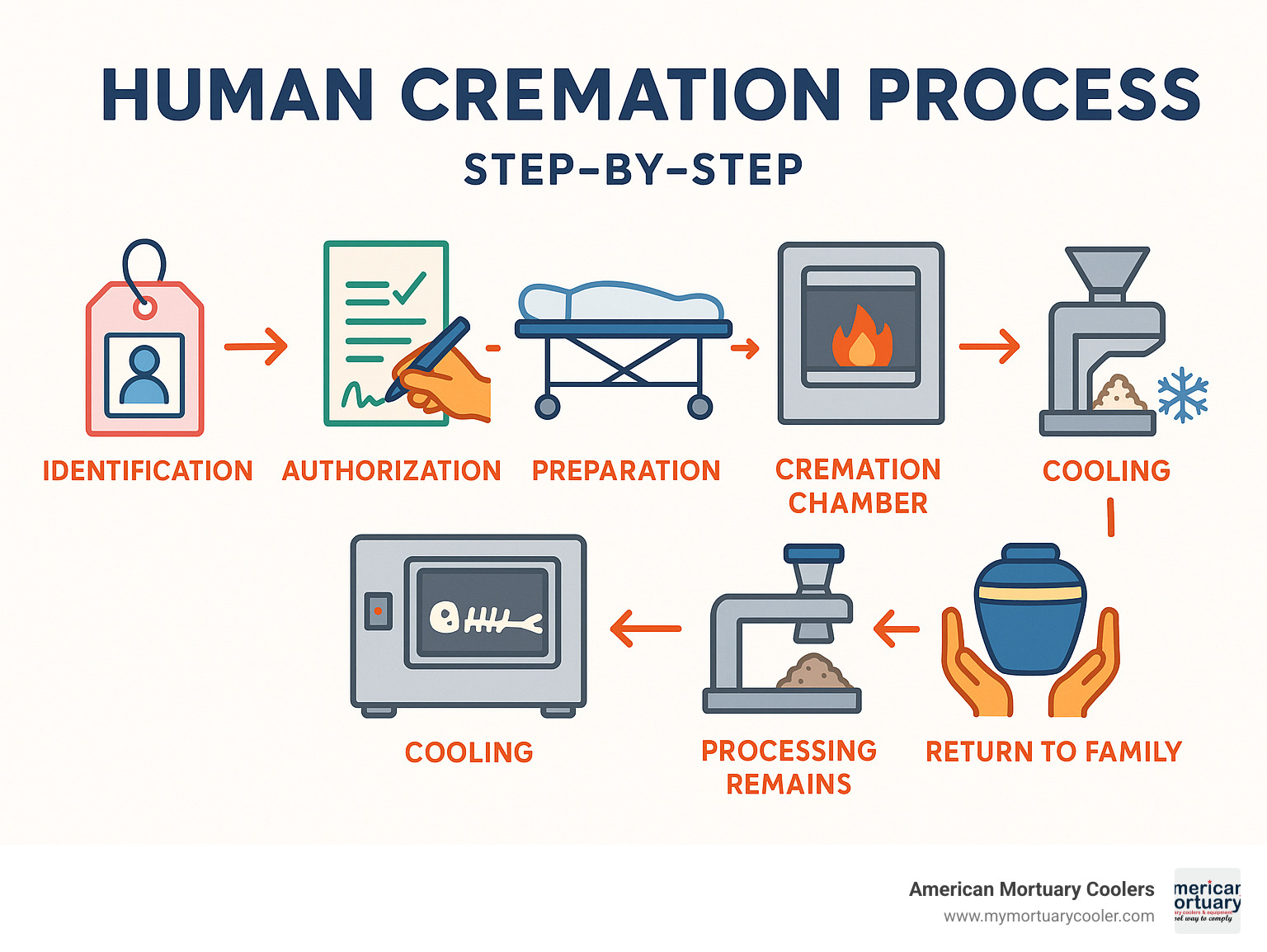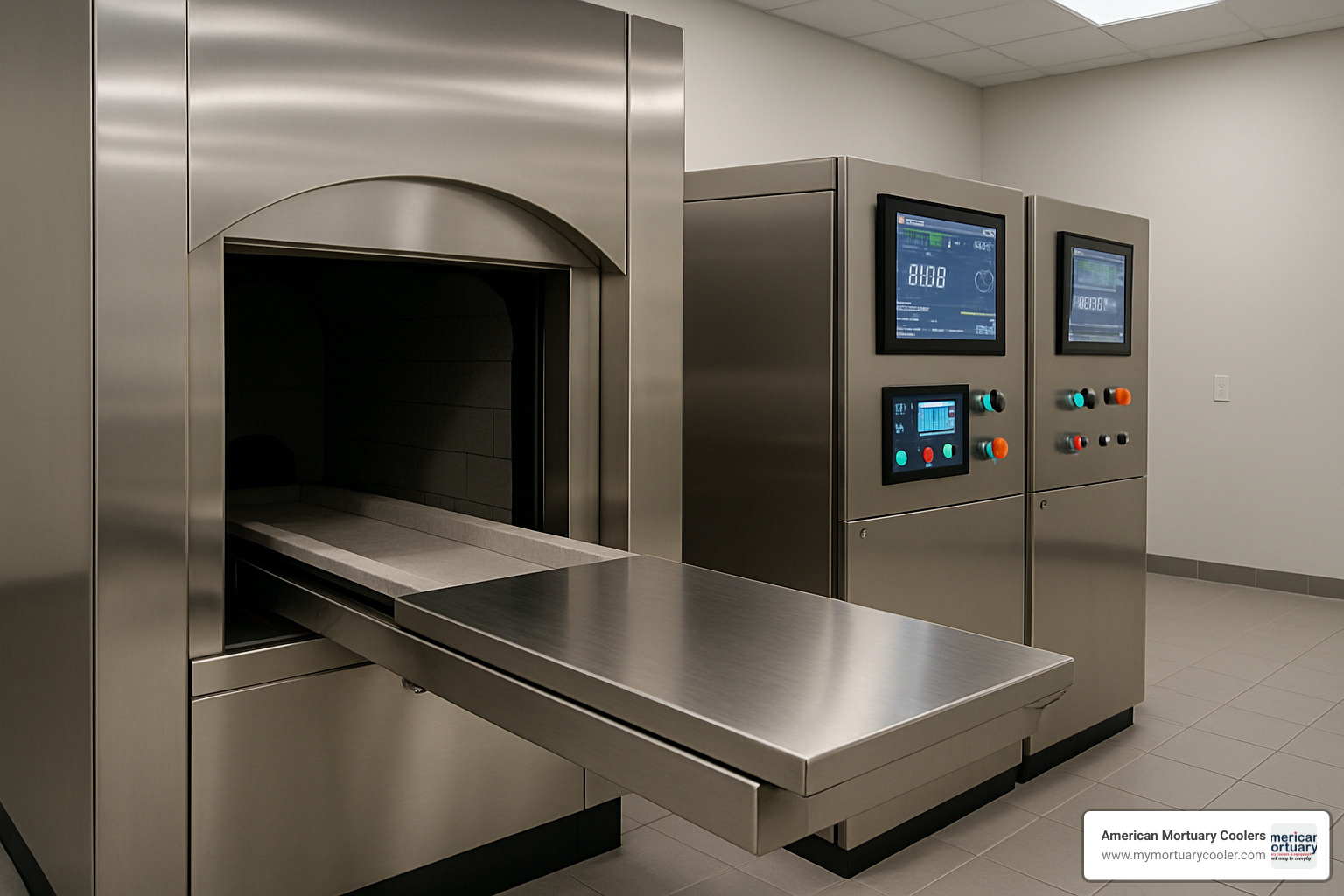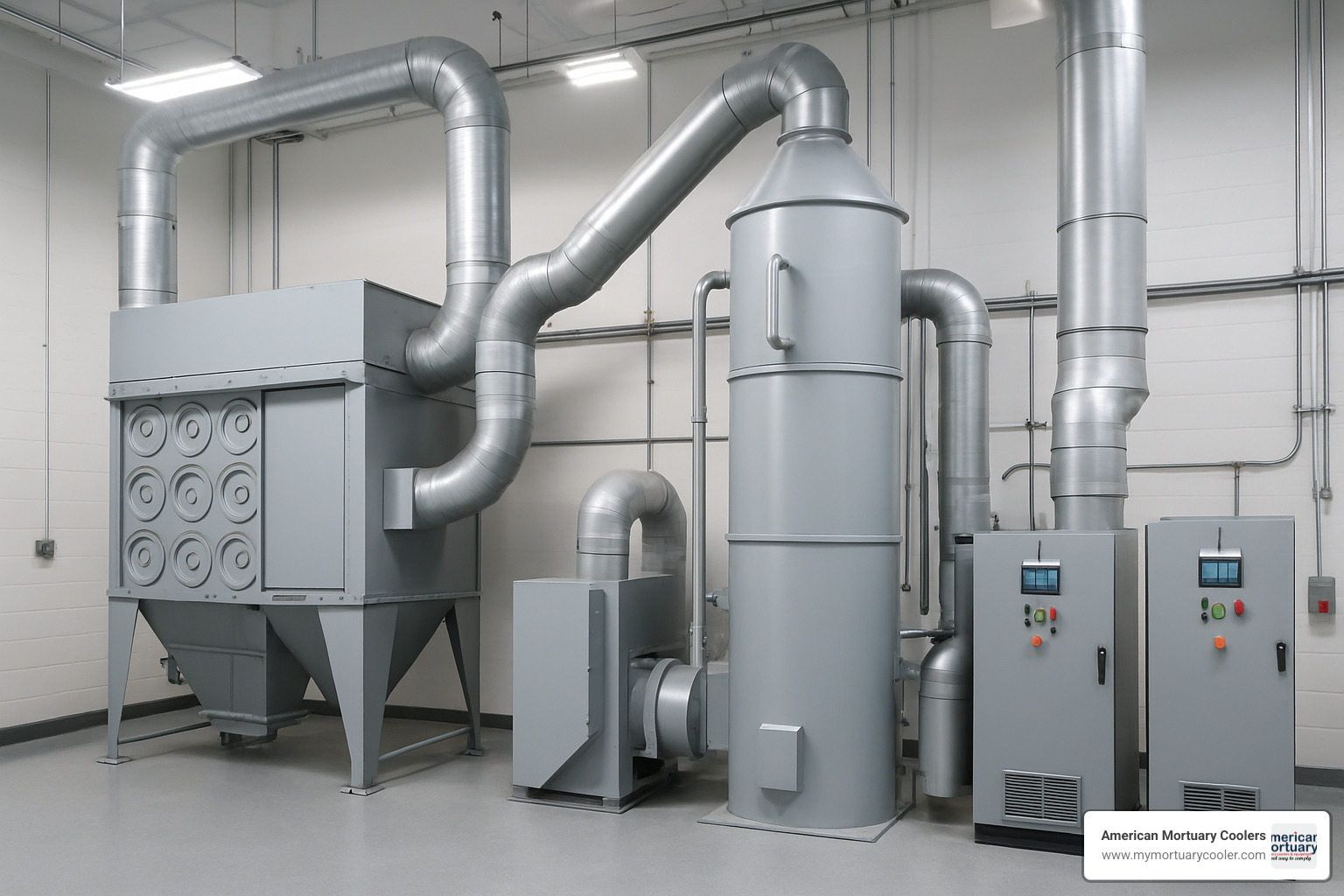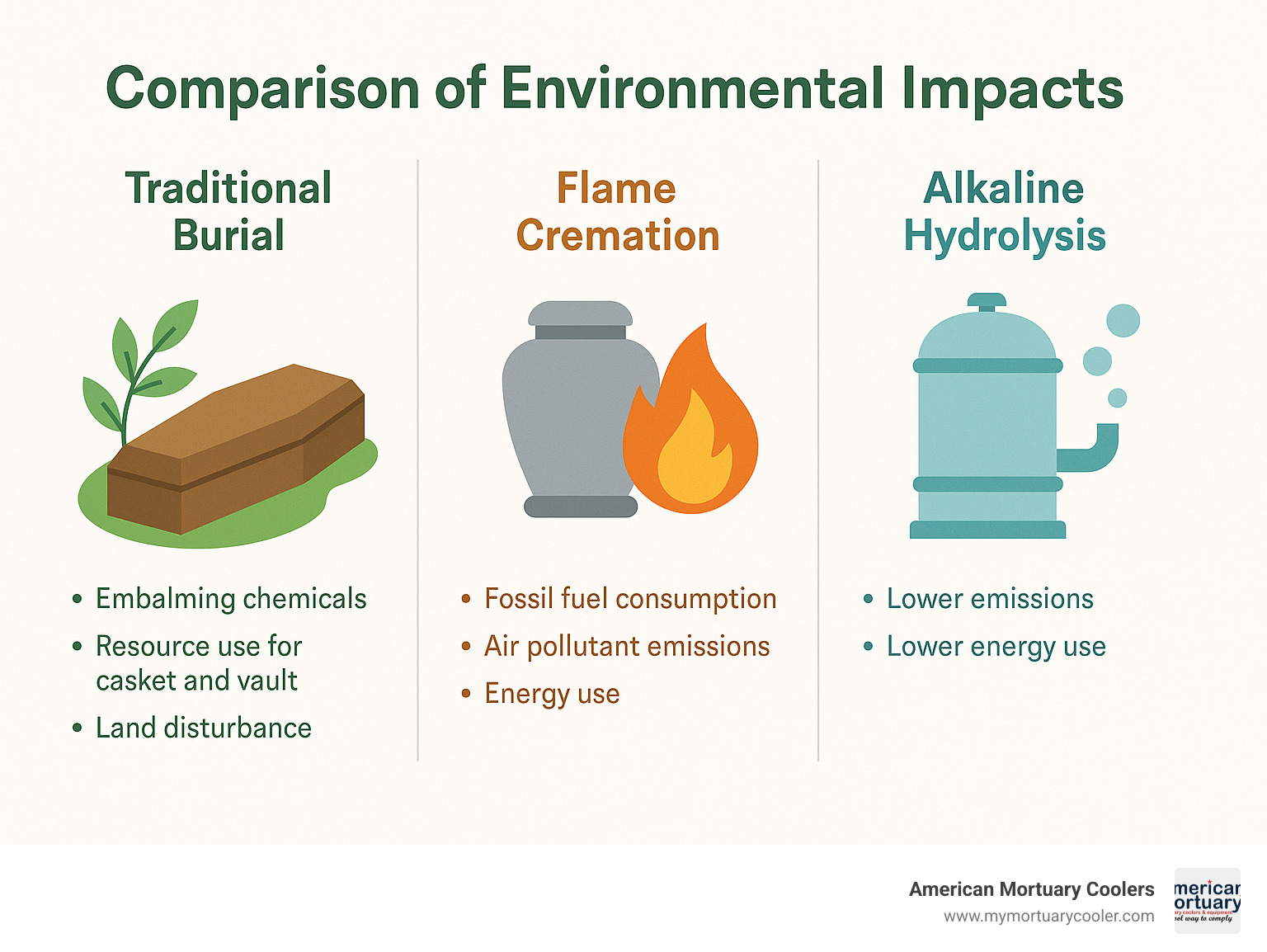Understanding the Modern Cremation Journey
Human cremation is a process that reduces a body to bone fragments through high heat (1400-1800°F), typically lasting 2-3 hours, followed by processing into a fine, sand-like material weighing 4-6 pounds. Over 50% of Americans now choose cremation, with rates projected to reach 78% by 2035.
Key Cremation Facts:
- Process: Body identification → authorization → preparation → cremation chamber → cooling → processing remains → transfer to urn
- Cost: Typically $1,000-$3,000 (vs. $7,000-$12,000 for traditional burial)
- Types: Flame-based (traditional), alkaline hydrolysis (water/green cremation)
- Duration: 2-3 hours for flame-based, up to 16 hours for alkaline hydrolysis
- Environmental impact: Traditional cremation produces about 240kg of CO₂; green cremation reduces carbon footprint by 75%
The practice has evolved from ancient open-air pyres to today's precisely controlled cremation chambers. The rising popularity stems from lower costs, environmental considerations, greater flexibility for memorial services, and changing religious attitudes.
Many families appreciate that cremation provides more time to plan meaningful memorials without the pressure of immediate burial. It also offers versatile options for keeping or scattering remains - from traditional urns to memorial diamonds, coral reefs, or even space launches.
I'm Mortuary Cooler, a national-level supplier of mortuary equipment with extensive experience providing cremation chambers and related equipment that meet the highest standards for human cremation processes.

Key terms for human cremation:
Understanding Human Cremation
Human cremation is the process that reduces human remains to bone fragments through mechanical, thermal, or other dissolution methods. This practice dates back at least 17,000 years, with archaeological evidence like the "Mungo Lady" remains found in Australia. What began as an ancient ritual has evolved to become the preferred choice for final arrangements in many cultures worldwide.
Modern cremation takes place in specialized equipment called retorts or cremation chambers, designed to reduce the body to its basic elements efficiently while maintaining dignity throughout the process.
According to the National Funeral Directors Association (NFDA), cremation rates continue to climb steadily, with projections reaching 78.8% by 2035. This significant change reflects evolving attitudes toward death and remembrance, along with practical considerations like affordability and environmental impact.
One aspect that gives families peace of mind is the strict chain of custody maintained during human cremation. Funeral homes and crematories follow rigorous protocols using permanent identification tags and thorough documentation to ensure you receive the correct cremated remains.
Scientific research on cremation statistics consistently shows cremation becoming more common across all demographics, driven by cost savings, flexibility for memorial planning, and growing environmental awareness.
Human Cremation Process Step-by-Step
The human cremation journey follows a carefully documented sequence:
First comes the authorization - the legal next of kin provides written permission before cremation can proceed, typically requiring a death certificate and state-mandated waiting periods of 24-48 hours after death.
Identification is paramount - a non-combustible tag with a unique number is attached to the body and remains throughout the entire process, maintaining identity even during cremation.
Preparation involves placing the body in a combustible container - typically a simple cardboard box or wooden casket. Jewelry, medical devices (especially pacemakers, which can explode during cremation), and non-combustible items are removed.
The container with the body is placed in the cremation chamber (retort), lined with heat-resistant bricks and reaching temperatures between 1400°F and 1900°F - hot enough to reduce the body to its mineral components.
The actual cremation involves two stages of combustion. Primary combustion occurs in the main chamber with the body, while secondary combustion happens in a separate chamber to fully burn gases and particles, significantly reducing emissions.
After approximately 2-3 hours, the cremation is complete, and the remains cool for 30-60 minutes before handling. The cooled bone fragments then go through a cremulator to create a uniform, sand-like consistency. Any metal remnants from dental work, joint replacements, or other medical implants are removed.
Finally, the processed remains - now called "cremains" - typically weigh between 4-6 pounds for adults and are transferred to an urn or temporary container for return to the family.
For funeral professionals interested in the technical aspects of cremation equipment, our A Practical Guide to Cremation Chambers and the Cremation Process offers detailed information.
Costs of Human Cremation vs. Burial
One compelling reason for the rising popularity of human cremation is economics. Cremation typically costs just one-third of what you'd pay for a traditional burial.
The average cremation costs between $1,000 and $3,000, depending on services selected and location. Compare that to traditional burial with a funeral service, casket, vault, and cemetery plot, which can run between $7,000 and $12,000 or more.
Direct cremation - where cremation happens shortly after death without a viewing or ceremony - is the most affordable option, sometimes available for as little as $500 to $1,000.
Here's how cremation and burial options compare:
| Service Type | Average Cost | Flexibility | Environmental Impact | Timeline |
|---|---|---|---|---|
| Direct Cremation | $500-$1,000 | High | Moderate | Immediate (after legal waiting period) |
| Cremation with Memorial | $1,000-$3,000 | High | Moderate | Flexible - service can be weeks/months later |
| Traditional Burial | $7,000-$12,000+ | Low | High | Usually within 3-7 days |
| Green Burial | $2,000-$5,000 | Moderate | Low | Usually within 3-7 days |
Types of Cremation & Emerging Technologies
The world of human cremation is evolving rapidly, with new methods addressing different family needs and growing environmental concerns.
Flame-Based Human Cremation
Traditional flame-based cremation remains the most common approach in the United States. This process takes place in a specialized chamber called a retort, typically powered by natural gas or propane.
Inside these chambers, temperatures reach between 1400°F and 1800°F—hot enough to reduce the body to bone fragments over a 2-3 hour period. Modern retorts feature sophisticated computerized controls that optimize the process while minimizing fuel consumption.
Metal implants like hip replacements and dental fillings don't burn—they remain behind after cremation. Most crematories now participate in recycling programs for these metals, with many donating the proceeds to charitable causes.
For funeral professionals wanting to understand the technical side of this equipment, our Cremation Retort 101 guide offers detailed insights.

Alkaline Hydrolysis (Water Cremation)
Alkaline hydrolysis, sometimes called water cremation, aquamation, or bio-cremation, uses water instead of fire. This innovative process accelerates the body's natural decomposition using a combination of water, alkaline chemicals, heat, and pressure.
The body rests in a pressurized stainless steel vessel filled with a solution of water and potassium hydroxide. The vessel heats to 200-300°F under pressure, allowing the solution to circulate around the body. Over 6-16 hours, this combination breaks down the body's soft tissues into a liquid.
The environmental benefits are impressive: water cremation uses only about 1/8 the energy of traditional cremation while reducing carbon emissions by more than 75%. It also eliminates concerns about mercury emissions from dental fillings. The sterile liquid byproduct can return safely to the water cycle or nourish plants as fertilizer.
After completion, only bone fragments remain, which are processed into a powder and returned to the family.
Currently about 20 states have approved water cremation, with more considering legislation. If you're interested in this gentler approach, check with local funeral directors about availability in your area.
For a deeper look at this emerging option, read our article: Could Water Cremation Become the New American Way of Death?
Green Improvements & Equipment
The funeral industry is increasingly embracing eco-friendly approaches to human cremation, developing innovations that honor both the deceased and our planet.
Promising green developments include bio-urns that combine cremated remains with soil and tree seeds, allowing loved ones to transform into new life. Many facilities are installing renewable fuel burners that operate on biogas or renewable natural gas, significantly reducing carbon footprint. Advanced emissions scrubbers and filtration systems capture harmful pollutants like mercury before they enter the atmosphere.
Energy efficiency is improving with heat recovery systems that capture and reuse heat from the cremation process. Even the containers used in cremation are evolving, with biodegradable options made from sustainable materials becoming more widely available.
For funeral professionals considering the financial aspects of these green technologies, our Complete Guide to Alkaline Hydrolysis Cremation Costs provides valuable insights into equipment investment and operational expenses.
What Happens After Cremation: Ashes, Memorials & Legalities
When the human cremation process concludes, families receive what many call "ashes" - though they're actually bone fragments processed into a fine, sand-like material. They're typically white to light gray with a texture similar to coarse sand, composed mostly of calcium phosphates and other minerals from the bone structure.
The quantity varies based on the person's size - most adults' remains weigh between 3 and 9 pounds, with men's remains often weighing more due to differences in bone density and body mass.
One of the beautiful aspects of cremation is the flexibility it provides for memorialization. Unlike traditional burial with its fixed timeline and location, cremation opens up countless possibilities that can be deeply personal and meaningful.
There are some legal considerations to keep in mind. The United States Postal Service allows shipping cremated remains via Priority Mail Express with special labeling, though other carriers like UPS and FedEx don't accept them. If you're planning to scatter remains, certain locations like national parks or ocean waters require permits.
Keeping or Scattering Cremated Remains
Many families choose to keep their loved one's remains close by using traditional urns, which come in countless materials and styles. These can be displayed at home, placed in a columbarium niche, or even buried in a cemetery plot if desired.
Home displays often become meaningful focal points for remembrance, sometimes accompanied by photographs and mementos. Some families choose to divide the remains among multiple family members.
For those drawn to scattering, the options are diverse. Many find comfort in returning their loved one to a meaningful landscape - perhaps a favorite hiking trail, garden, or family property. Water scatterings in oceans, lakes, or rivers can provide a sense of returning to nature, though environmental regulations require ocean scatterings to take place at least three nautical miles from shore.
Many cemeteries now offer dedicated scattering gardens, providing a beautiful, maintained space specifically designed for this purpose.
Creative Uses for Ashes
Beyond traditional options, remarkable innovations have expanded the possibilities for honoring loved ones. Memorial diamonds can be created from the carbon in cremated remains, transformed through the same heat and pressure processes that form natural diamonds.
Glass art offers another beautiful option, with skilled artists incorporating small amounts of remains into blown glass creations. For those who loved the stars, space launch services will carry a portion of remains into Earth orbit, to the Moon, or even into deep space.
Some choose more personal memorials - having a small amount mixed with tattoo ink for a permanent tribute. Ocean lovers might appreciate artificial reef structures that incorporate remains into environmentally beneficial habitats for marine life.
Maintaining Identity & Compliance
Throughout the entire cremation process, maintaining proper identification is critical. Funeral homes and crematories follow strict protocols to ensure families receive the correct remains of their loved ones.
The cornerstone of this system is a stainless steel identification disc with a unique number that stays with the body throughout cremation. This non-combustible tag survives the high temperatures and is recovered afterward.
Multiple verification checkpoints require staff to confirm identity at each stage, with thorough documentation creating a paper trail. Many facilities also offer a witnessing option where family members can observe the beginning of the cremation process if desired.
State regulations govern these procedures, with specific laws about identification requirements and record-keeping that crematoriums must follow.
For more detailed information on these procedures, the "Scientific research on chain of custody" provides valuable insights into how these systems protect families.
Environmental & Health Impacts
When families consider human cremation, they increasingly want to understand its environmental footprint. While cremation offers certain ecological advantages over traditional burial, it's important to have a clear picture of its impact.
Each human cremation releases approximately 240 kg (about 530 pounds) of carbon dioxide into the atmosphere. Beyond this carbon footprint, the process can produce other emissions including volatile organic compounds, particulate matter, and sulfur and nitrogen oxides. Of particular concern is mercury released from dental fillings, which can enter the air unless captured by specialized filtration systems.
Today's crematories increasingly feature advanced pollution control devices that significantly reduce harmful emissions. These systems are particularly effective at capturing mercury and particulates.
When weighing cremation against traditional burial, the environmental comparison becomes complex. Traditional burial involves embalming chemicals like formaldehyde, hardwood or metal caskets that decompose very slowly, concrete burial vaults, and permanent land use requiring ongoing maintenance. A comprehensive life cycle assessment by environmental scientist Elisabeth Keijzer in 2017 found that cremation often has a lower overall environmental impact than conventional burial, though both leave significant ecological footprints.
Reducing the Footprint of Human Cremation
The funeral industry is actively developing ways to make human cremation more environmentally friendly:
Modern cremation equipment features significantly improved fuel efficiency, requiring less natural gas or propane per cremation. Some facilities have installed innovative hybrid burners that can use multiple fuel sources, potentially including renewable options. Heat recovery systems capture and reuse thermal energy from the cremation process, improving overall efficiency.
Alkaline hydrolysis (water cremation) represents perhaps the most significant advancement, producing dramatically lower emissions while using just a fraction of the energy required for flame-based cremation. Even simple changes like using biodegradable containers instead of traditional caskets can meaningfully reduce environmental impact.


Regulatory Landscape & Certifications
Human cremation operates within a complex regulatory framework designed to protect public health, maintain dignity in handling remains, and limit environmental impacts.
While the EPA doesn't have regulations specifically targeting crematories, these facilities must comply with general air quality standards. The regulatory picture becomes more detailed at the state level, where most jurisdictions require specific permits, licenses, and regular inspections.
The Cremation Association of North America (CANA) provides valuable guidance through its published best practices and voluntary standards. These industry guidelines often influence formal regulations and help crematory operators maintain high professional standards.
Local zoning and land use regulations add another layer of oversight, determining where crematories can operate and sometimes imposing additional requirements based on community concerns.
The regulatory environment continues to evolve, particularly regarding newer technologies like alkaline hydrolysis. As of 2019, about 20 states have explicitly legalized this water-based alternative, with others actively considering similar legislation. One factor driving these regulatory changes is the growing shortage of cemetery space, especially in urban areas.
Frequently Asked Questions about Human Cremation
When families face the loss of a loved one, they often have questions about human cremation - especially if this is their first experience with the process. Here are some of the most common questions we hear from families.
Do bodies move or "sit up" during human cremation?
This question comes up more often than you might think, likely because of dramatic portrayals in movies or urban legends.
The truth is much less dramatic. Bodies do not sit up during cremation. While there can be some minor muscle contractions as tissues dry out from the intense heat, these are minimal movements - nothing like the theatrical "sitting up" sometimes depicted in horror films.
Modern cremation chambers reach temperatures between 1400-1800°F very quickly, which essentially immobilizes the body almost immediately after the process begins. The cremation chamber itself typically doesn't have enough vertical space to allow for significant movement.
How much time passes between death and the cremation?
Most states have laws requiring a waiting period - typically 24-48 hours - between death and cremation. This waiting period serves several important purposes:
It allows time for proper authorization and paperwork to be completed, provides an opportunity for family members to view the body if they wish, and ensures that any questions about the cause of death can be properly addressed.
During this waiting period, the body is kept in specialized refrigeration units. At American Mortuary Coolers, we provide high-quality mortuary refrigeration systems designed specifically to maintain appropriate conditions until cremation can take place.
The exact timing depends on several factors, including state law requirements, the schedule of the crematory, whether a viewing or funeral service will take place beforehand, and how quickly all necessary paperwork and authorizations can be completed.
Can multiple bodies be cremated together?
No - U.S. law strictly prohibits the cremation of multiple bodies together. Each person must be cremated individually, with strict identification procedures to ensure the correct cremated remains are returned to each family.
Cremation chambers are designed for a single body, and reputable crematories follow rigorous protocols to maintain identity throughout the entire process. These include:
Unique identification tags that remain with the body, complete clearing of the crematory between cremations, thorough documentation verifying each step, and options for family witnessing of the beginning of the cremation if desired.
Conclusion
As we've explored throughout this guide, human cremation has evolved dramatically from ancient practices to become a sophisticated, regulated process. Today, it offers families dignity, flexibility, and increasingly eco-friendly options for saying goodbye to their loved ones.
The growing popularity of cremation reflects our changing cultural attitudes, practical considerations like cost savings, and a rising environmental consciousness. With projections showing nearly 80% of Americans choosing cremation by 2035, understanding this process has never been more relevant.
At American Mortuary Coolers, we take pride in supporting funeral professionals across the country. Based in Tennessee with service throughout the contiguous 48 states, we craft high-quality, custom equipment designed specifically for modern cremation facilities. Our mortuary coolers and related equipment are built with both durability and performance in mind, helping funeral professionals provide the dignified, efficient services that families deserve during difficult times.
When considering cremation, whether you're planning ahead or making decisions during a time of loss, we encourage families to follow these thoughtful steps:
First, choose trusted providers who maintain proper licensing and follow strict identification protocols. Second, plan ahead whenever possible to allow for thoughtful decisions without the pressure of immediate grief. Third, consider the environmental impact of your choices – perhaps exploring greener options like alkaline hydrolysis where available. Finally, take time to understand all available options for memorialization – from traditional urns to innovative choices like memorial diamonds or reef structures.
The journey of saying goodbye is deeply personal. Whether you choose traditional flame-based cremation or newer alternatives, what matters most is finding options that provide comfort and meaning for your family.
For funeral professionals interested in upgrading their facilities or learning more about our cremation equipment solutions, we invite you to explore More info about our cremation equipment solutions.

















